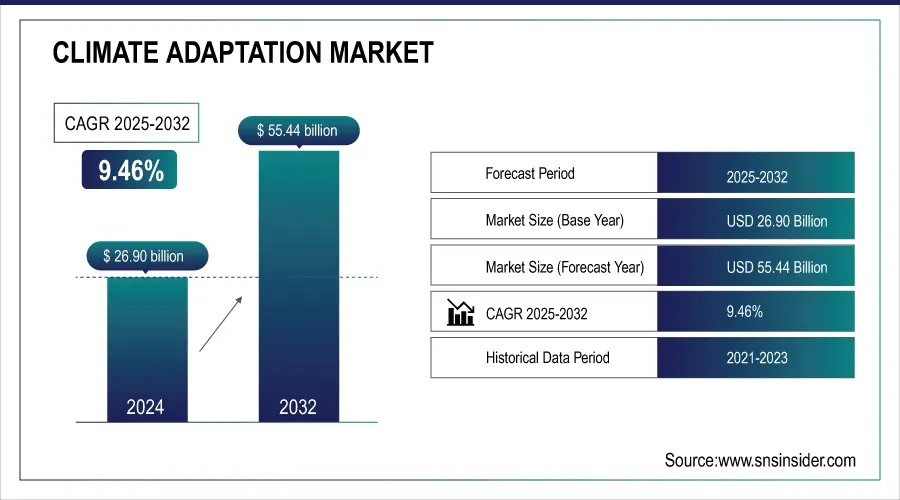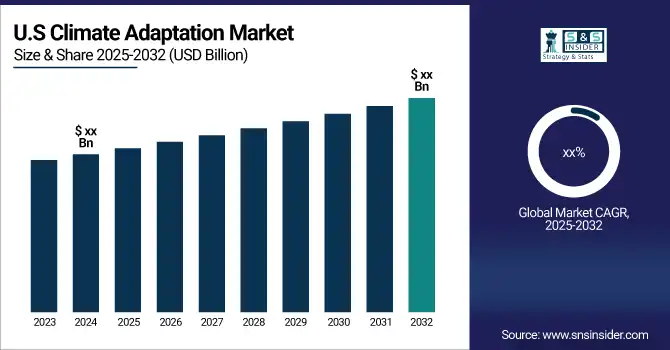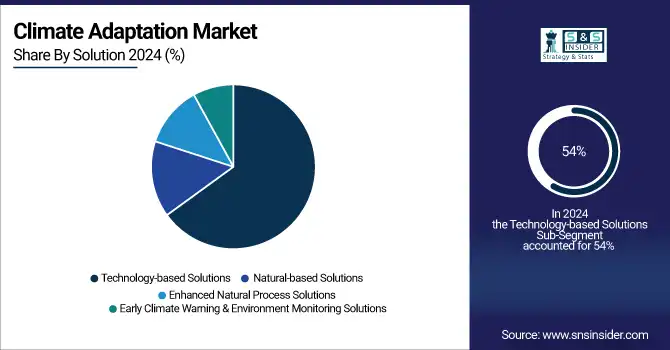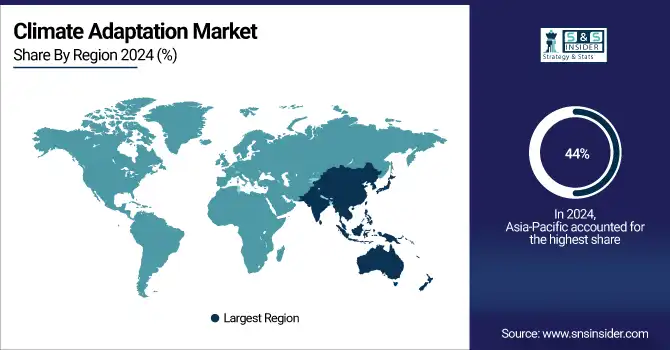Climate Adaptation Market Size & Trends:
The Climate Adaptation Market Size was valued at USD 26.90 billion in 2024 and is expected to reach USD 55.44 billion by 2032 and grow at a CAGR of 9.46% over the forecast period 2024-2032. The major driving factors for the market growth are the rise in awareness regarding the impacts due to climate change, government support, funding for climate resilience projects, advancements in technologies with respect to data analysis, and monitoring to curb the resources, and an increasing demand for sustainable solutions into the several sectors. In addition, there is a diversion of funding towards innovative climate adaptation mechanisms, and organizations will have a faster technological adoption mechanism in place as they strive for effective solutions. Gaps in adaptation by region are also emerging, leading to a call for focused investments to build resilience in at-risk areas.

To get more information on Climate Adaptation Market - Request Free Sample Report
Market Size and Forecast:
-
Market Size in 2024: USD 26.90 Billion
-
Market Size by 2032: USD 55.44 Billion
-
CAGR: 9.46% from 2025 to 2032
-
Base Year: 2024
-
Forecast Period: 2025–2032
-
Historical Data: 2021–2023

Key Climate Adaptation Market Trends
-
Increasing adoption of resilient infrastructure to withstand climate-related risks.
-
Rising investment in sustainable agriculture and water management solutions.
-
Integration of climate adaptation strategies in urban planning and smart cities.
-
Growing demand for advanced weather forecasting and early warning systems.
-
Expansion of climate-resilient insurance and risk assessment services.
-
Government policies and incentives driving climate adaptation projects.
-
Technological innovations in renewable energy and energy-efficient systems.
-
Rising awareness among businesses and communities about climate-related vulnerabilities.
Climate Adaptation Market Growth Drivers
-
Urgent Call for Climate Adaptation in Response to Escalating Extreme Weather Events
Increasing extreme weather events, including heatwaves, droughts, and floods, have emerged as a significant global challenge. The Northern Hemisphere just had its hottest summer, and 2024 could break records, too, scientists predict. A destructive wave of tornadoes – with more than 100 tornadoes spiraling through the Midwest and Great Plains states in just four days – has ricocheted through parts of the United States, resulting in widespread damage and loss of life. In India, meanwhile, extreme weather resulted in 2,923 deaths, and 2 million hectares of crops and 80,000 homes destroyed between January and September 2023, according to the Center for Science and Environment (CSE). According to the Jet Propulsion Laboratory, the sea levels are rising at an extraordinary rate, increasing 0.3 inches from 2022 to 2023, putting coastal communities at risk and further worsening storms. Such is the recognition of the urgent need for strong climate adaptation strategies.
Climate Adaptation Market Restraints
-
Fragmented Policies and Regulations as a Barrier to Effective Climate Adaptation Strategies
Fragmented policies and regulations present a significant restraint in the climate adaptation market, as inconsistent frameworks across various regions create obstacles for implementing effective strategies. Different governmental bodies may have varying priorities, which can lead to a lack of coherence in climate adaptation efforts. For instance, local, regional, and national policies may not align, resulting in confusion and inefficiencies in resource allocation. This disjointed approach often hampers collaboration between stakeholders, including governments, businesses, and communities, making it difficult to develop unified strategies that address local climate challenges effectively. Moreover, the absence of standardized regulations can create uncertainties for investors and project developers, discouraging investment in adaptation initiatives. To overcome these challenges, a more integrated policy framework is essential, ensuring that all levels of government work together toward common climate adaptation goals.
Climate Adaptation Market Opportunities
-
The potential for carbon removal technologies presents significant opportunities for addressing climate challenges and advancing sustainability efforts.
Investments in carbon removal technologies are increasingly critical as the urgency for climate adaptation escalates. Recent fires in Los Angeles underscore the pressing need for advanced climate adaptation solutions, bolstering the case for heightened funding in carbon management technologies. The relationship between nuclear power and climate change further highlights the necessity for innovative carbon removal strategies (IAEA). Furthermore, discussions surrounding artificial intelligence (AI) stress the importance of timely action in carbon management, as technological advancements can greatly improve the effectiveness of these solutions (World Economic Forum). The European Union's initiative to scale up carbon dioxide removals presents both opportunities and challenges that require strategic navigation (Climate Advisory Board). Together, these developments reflect a significant interest in carbon removal technologies, promoting meaningful advancements in climate adaptation efforts. The stakes are high, as last year was declared the hottest on record by the World Meteorological Organization, with extreme weather events leading to substantial global costs. In the U.S., 27 climate-related disasters in 2024 caused damages totaling USD 182.7 billion, highlighting the financial consequences of climate change. The rapid growth of AI raises concerns about whether its deployment will outstrip clean energy expansion, with enterprise AI spending projected to reach USD 407 billion by 2027, while the International Energy Agency (IEA) anticipates that renewables could provide nearly half of the world’s electricity by 2030.
Climate Adaptation Market Challenges:
-
Challenges in monitoring and evaluating climate adaptation measures hinder accountability and continuous improvement.
Monitoring and evaluation (M&E) are crucial components of effective climate adaptation strategies, yet they pose significant challenges. Differences in climate impacts can complicate the development of standard measures for evaluating the efficacy of adaptation measures. Without clear indicators and sound data, it may be difficult for decision-makers to assess whether governance strategies implemented so far have been producing positive results or effectively addressing vulnerabilities. . This lack of clarity can hinder accountability, as stakeholders may not be able to track progress or identify areas needing improvement. Moreover, inadequate M&E systems can result in wasted resources, as ineffective measures remain in place without being adequately assessed. improvement in climate adaptation, robust M&E frameworks must be established to ensure that strategies are adaptable, transparent, and responsive to evolving climate risks.
Climate Adaptation Market Segment Analysis
By Solution
The Technology-based Solutions segment of the climate adaptation market is expected to dominate with around 54% of total revenue in 2023, indicating the significance of technology in overcoming the challenges posed by climate. Technologies through artificial intelligence (AI), advanced data analytics, and remote sensing are key to monitoring, evaluating, and predicting climate-related risks. AI can analyse vast data sets to help decision-making by identifying trends, helps, and remote sensing for real-time perception of the environment. As climate-related catastrophes rise, demand for such solutions will follow to the tune of the major tech companies developing products for agriculture, urban planning, and more helping to embed sustainable practices into both public and private sectors and aligning with global climate initiatives.
The Early Climate Warning and Environment Monitoring Solutions segment is projected to experience the fastest growth in the climate adaptation market during the forecast period from 2024 to 2032. This is largely due to the rising incidents of extreme weather events as well as other climate-related crises, countries are in need of timely and accurate information to help mitigate, stabilize, and implement strategies to cope with the effects of climate change. These solutions increasingly incorporate advanced technologies such as satellite imaging, IoT sensors, and predictive analytics, providing real-time information about environmental conditions. Investments in early warning systems and monitoring solutions are projected to increase as governments, businesses, and communities look to strengthen their resilience to climate impacts. This rise in innovation and adoption in this vital area of climate adaptation.

By Industry
In 2023, the government segment commanded the largest revenue share in the climate adaptation market, accounting for approximately 41%. This dominance reflects the crucial role that state entities play in enforcing climate policies, financing adaptation efforts, and creating regulations. Around the world, governments are pouring money into infrastructure improvements, research, and community resilience programs to address the effects of climate change. They are also working with the private sector and the international community to build adaptive capacity. Governments are placing an increased emphasis on adaptation solutions as climate impacts worsen, leading to increased capital allocations and initiatives that drive growth in this segment and encourage sustainable practices.
The Power Generation segment is poised to be the fastest-growing sector in the climate adaptation market during the forecast period from 2024 to 2032. This growth is spurred on by the immediate necessity to improve energy resilience in light of climate change, which can have a serious effect on the production and distribution of energy. But how to take advantage of Solar, Wind and Hydroelectric power to get rid of the traditional means of power generation to time-saving, and naturally work that, to adopt no energy consumption era. In addition, these technologies help to reduce greenhouse gas emissions and enhance the adaptability of power systems to changing environmental conditions.
Climate Adaptation Market Regional Analysis
Asia Pacific Climate Adaptation Market Insights
The Asia-Pacific region dominates the climate adaptation market, representing around 44% of the global share in 2023. This leadership flows from accelerated economic development, increased exposure to climate disasters, and government policies that have institutionalized climate resilience. With innovative adoption strategies, countries such as China, India, Japan and Australia are some of those who are being active. China is where the money and the know how have been invested, in supplanting the collapse of infrastructure and ensuing natural disasters. Japan aims for disaster risk reduction and sustainable urban development; India is stepping up climate adaptation in farming and water resources. France confronts droughts and wildfires through dry land management and water conservation. This dedication to sustainability makes this region a key player in worldwide efforts to adjust to climate change.

Get Customized Report as per Your Business Requirement - Enquiry Now
North America Climate Adaptation Market Insights
North America is projected to see the fastest growth in the climate adaptation market from 2024 to 2032, due to awareness of climate risks and a need for resilient infrastructure heavily influencing the need for the climate adaptation industry, as well as large investments in sustainable practices. The U.S. is emphasizing plans to strengthen coastal protection systems, build improved systems to manage water and invest in green technologies that can help mitigate extreme weather. And government policies that seek to cut carbon emissions and encourage the adoption of renewable energy generate even greater demand for adaptation solutions. And Canada is also working to protect natural ecosystems, and address climate change impacts among Indigenous peoples as well. This emphasis on climate resilience positions North America as a leader in climate adaptation at this time.
Europe Climate Adaptation Market Insights
Europe is expected to account for 28.5% of the global Climate Adaptation market in 2024, driven by strong adoption of resilient infrastructure, climate-smart agriculture, and urban flood management solutions. Countries such as Germany, France, and the UK are leading investments in climate-resilient technologies, renewable energy integration, and sustainable water management. Government policies supporting carbon neutrality and climate adaptation strategies, coupled with growing R&D initiatives, reinforce Europe’s position as a leading region in climate resilience and sustainability solutions.
United States Climate Adaptation Market Insights
The United States dominates the Climate Adaptation market with a 42.3% share in 2024, fueled by large-scale adoption of advanced climate monitoring systems, disaster risk management solutions, and sustainable urban planning initiatives. Key states such as California, Florida, and New York are central to innovation in climate-resilient infrastructure, smart grid technologies, and extreme weather preparedness. Federal funding, state-level incentives, and private-sector investments are accelerating adoption of climate adaptation solutions across urban, industrial, and agricultural sectors.
Latin America (LATAM) Climate Adaptation Market Insights
Latin America holds 11.4% of the Climate Adaptation market in 2024, driven by increasing awareness of climate risks, urban resilience projects, and sustainable agriculture initiatives. Countries such as Brazil and Mexico are witnessing growing deployment of early warning systems, flood control measures, and climate-smart agricultural practices. Government programs promoting climate resilience, along with partnerships with international organizations and private players, are strengthening LATAM’s position as an emerging market for climate adaptation solutions.
Middle East & Africa (MEA) Climate Adaptation Market Insights
The Middle East & Africa region is projected to hold 18.5% of the global Climate Adaptation market in 2024, fueled by investments in water conservation, desertification control, and renewable energy integration. Saudi Arabia, the UAE, and South Africa are leading the adoption of climate-resilient infrastructure and smart city initiatives. Regional focus on sustainable urban development, coupled with collaborations with global technology providers, is accelerating market growth, positioning MEA as a high-potential region for climate adaptation solutions.
Climate Adaptation Market Competitive Landscape
ClimeCo
ClimeCo is a U.S.-based provider of climate solutions and sustainability services, focused on enabling organizations to meet environmental and regulatory goals.
-
In January 2024, ClimeCo announced a comprehensive brand refresh, including a revamped graphic identity, a new e-commerce platform, and a searchable insights library. This initiative aims to broaden its portfolio of climate adaptation solutions while providing clients with educational resources and real-world sustainability case studies.
IBM & NASA
IBM, in collaboration with NASA, is a global technology and research leader developing advanced AI solutions for climate and weather applications.
-
In September 2024, IBM and NASA released an open-source AI foundation model for weather and climate analysis. Designed with insights from Oak Ridge National Laboratory experts, the model enhances localized forecasting, extreme weather prediction, and global climate simulations, demonstrating improved accuracy in experimental data reconstructions.
Climate Adaptation Market Key Players
Some of the Major Key Players in Climate Adaptation Market along with their product:
-
BARANI DESIGN Technologies s. r. o. (Czech Republic - Climate Data Solutions)
-
Campbell Scientific, Inc. (USA - Environmental Monitoring Equipment)
-
Carbon Engineering ULC (Canada - Direct Air Capture Technology)
-
Climeworks (Switzerland - Carbon Capture Technology)
-
CAPA Strategies, LLC. (USA - Climate Adaptation Consulting)
-
DTN (USA - Weather and Climate Intelligence)
-
Esri (USA - Geographic Information Systems (GIS) Software)
-
Global Thermostat (USA - Carbon Removal Technology)
-
IBM Corporation (USA - AI and Data Analytics for Climate Solutions)
-
ClimeCo LLC (USA - Environmental Commodities and Sustainability Solutions)
-
AquaVitas (Netherlands - Water Treatment Solutions)
-
Sierra Club (USA - Environmental Advocacy and Climate Action)
-
Apex Clean Energy (USA - Renewable Energy Development)
-
First Solar, Inc. (USA - Solar Energy Solutions)
-
Verra (USA - Carbon Credit Standards and Certification)
List of Suppliers that provide raw materials and components for the climate adaptation market:
Raw Material Suppliers:
-
BASF SE
-
Dow Inc.
-
Saint-Gobain
-
Hexcel Corporation
-
U.S. Silica Holdings, Inc.
Component Suppliers:
-
Siemens AG
-
Schneider Electric
-
Trina Solar Limited
-
Vestas Wind Systems A/S
-
GE Renewable Energy
| Report Attributes | Details |
|---|---|
| Market Size in 2024 | USD 26.90 Billion |
| Market Size by 2032 | USD 55.44 Billion |
| CAGR | CAGR of 9.46% From 2025 to 2032 |
| Base Year | 2024 |
| Forecast Period | 2025-2032 |
| Historical Data | 2021-2023 |
| Report Scope & Coverage | Market Size, Segments Analysis, Competitive Landscape, Regional Analysis, DROC & SWOT Analysis, Forecast Outlook |
| Key Segments | • By Solution (Natural-based Solutions, Technology-based Solutions, Early Climate Warning & Environment Monitoring Solutions) • By Industry (Oil & Gas, Power Generation, Chemical & Petrochemical, Government, Education, Others) |
| Regional Analysis/Coverage | North America (US, Canada), Europe (Germany, France, UK, Italy, Spain, Poland, Russsia, Rest of Europe), Asia Pacific (China, India, Japan, South Korea, Australia,ASEAN Countries, Rest of Asia Pacific), Middle East & Africa (UAE, Saudi Arabia, Qatar, Egypt, South Africa, Rest of Middle East & Africa), Latin America (Brazil, Argentina, Mexico, Colombia Rest of Latin America) |
| Company Profiles | ARANI DESIGN Technologies s. r. o. (Czech Republic), Campbell Scientific, Inc. (USA), Carbon Engineering ULC (Canada), Climeworks (Switzerland), CAPA Strategies, LLC. (USA), DTN (USA), Esri (USA), Global Thermostat (USA), IBM Corporation (USA), ClimeCo LLC (USA), AquaVitas (Netherlands), Sierra Club (USA), Apex Clean Energy (USA), First Solar, Inc. (USA), Verra (USA). |

